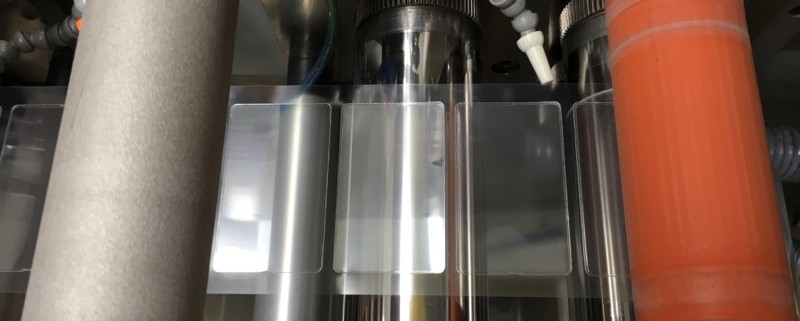How to Properly Cut VHB Adhesive for Touchscreen Gaskets
/in Rotary /by atiadminTouch screen gaskets are best made with VHB adhesive and are harder to make than you think because if not done properly, the release liner doesn’t release.
Many product engineers love Very High Bond Tape (or VHB tape)because of its viscoelasticity (it “floats” well), but it is by definition sticky… very sticky. That’s what it supposed to be. But as a long-standing, high volume VHB tape converter, we know that if you don’t do it right, there are going to be problems, especially with the release liner.
Clients come to us when other converters have failed them.
Some of the most typical problems we hear about are release problems. Many converters don’t have enough expertise with cutting VHB adhesive to know that when you cut it, you can’t web it because the part will weld back together. The solution is to use an agent to assist in handling the VHB tape, but often the release agents can negatively impact the performance of the part during assembly and production.
That’s what happened with one of our clients in the electronic industry. They needed touch screen gaskets for a recreational vehicle. They had gone to another converter to get the part, but during production, the touch screen gaskets were not holding up.
That’s when they called us. The client had experience with the other company but needed parts that worked right away. Because Gasket Engineering is a 3M Preferred Partner, we were able to get the VHB adhesive materials in from 3M quickly, clear the right rotary tools necessary to do the job properly, and deliver the touch screen gaskets in six business days.
Gasket Engineering used its long-standing expertise, unique processes and specialized tool and equipment to ensure that the job was done right. The supply chain manager at this electronic company explained it this way, “We approached Gasket Engineering for help in solving a customer issue regarding the difficulty of removing the factory liner on the VHB adhesive used on one of our products. Albert and the Gasket Engineering team were able to quickly offer samples of our part showing us several options of custom liners. The final solution was well received and we have since switched to the new liner on another part as well. Gasket Engineering’s innovative thinking and can-do approach has allowed us to improve our customer’s experience when installing our product on their equipment.”
To learn more, you can check out our webpages on rotary cutting, VHB tape and what it means to be a 3M Preferred Converter.
If your part calls for VHB tape, let the experts at Gasket Engineering ensure that the job is done properly. Contact us today to put our expertise to work for you!
If I Need Rotary Tooling, Why Should I Get a Steel Rule Die?
/in Rotary /by atiadminWhile material costs are always the biggest determinant of overall cost, rotary tooling is another key expense. The rotary cutting process is much faster and typically requires less labor than traditional die cutting processes. This is why, for large volume of orders, rotary cutting is a logical answer to help our clients save time and money. However, rotary tooling can cost up to 7-10 times that of traditional steel rule die tooling because there are more complex and there are multiples–a series of hardened steel dies that cut first the interior and then finally the exterior cuts. This cost is usually amortized over the large quantity of parts and is therefore not typically a constraining factor in the overall cost of a project.
Except if you get it wrong.
When you invest in rotary tooling, you want to know that what you’re producing will work. One way to ensure this is to invest in some hardened steel rule die tooling (typically associated with traditional flat die cutting processes) to test that the part itself will work within the context of the particular production process that will be used. GEC has found that when developing the part for the first time, engineers (understandably) tend to make a lot of changes in an effort to get it just right. Often the most fiscally prudent course of action is to invest in that additional tooling upfront to ensure that the proposed production process will accept the part being created and that all works smoothly. Spending a little extra money today on tooling can save a ton of money, time, and aggravation down the road.
This is another example of how GEC partners with its customers to make sure they’re getting it right–giving the customer not just what they ask for but verifying with them that it is meeting their needs. As one GEC expert put it, “what’s the point of getting one 10,000 piece order and having all of those pieces be all wrong and having them go somewhere else. We want to build long-term relationships with our customers and be trusted advisor for the long term.
If you would like help with a rotary project, check out our rotary services page or give us a call at 816-363-8333.
Complex Rotary Cutting to Fuse Five Layers Into One
/in Rotary, Uncategorized /by atiadminScientific and medical lab equipment can be very complex so when CLARCOR Industrial Air needed to make a multilayered solution cup vent for one of its clients, the company turned to Gasket Engineering.
CLARCOR is a manufacturer of ePTFE membrane, and it needed to laminate five layers to create a single film for a lab and process industry application. Gasket Engineering’s rotary cutting equipment allowed them to create a sophisticated and intricate product to meet the client’s needs.
Sarah Propp, product development engineer for CLARCOR Industrial Air explains, “The project was fairly complex, requiring us to layer membrane with an aluminum liner. The five-layer film included a support layer, the vent membrane and a pressure sensitive adhesive bonded to aluminum all adhered to an easy to handlerelease liner. While many other converters can’t generally handle layering multiple materials and multiple geometrics into a single product, Gasket Engineering told me ‘No problem’ and went about figuring out how to accomplish what we needed. They are out-of-the-box thinkers who have experience converting materials in non-typical ways.”
With a wide range of machinery available and an innovative approach, Gasket Engineering can convert materials in complex ways that others can’t. If you’re looking for a converter with a unique combination of broad capabilities, creative thinking and a can-do attitude, let the team of experts at Gasket Engineering solve your converting challenges. Give us a call at 816.363.8333 or send a note to gecsales@gasketeng.com
Latest News
 Gasket Engineering is ISO 9001:2015 Certified!October 28, 2017 - 4:14 am
Gasket Engineering is ISO 9001:2015 Certified!October 28, 2017 - 4:14 am We’re in the press (again)!May 25, 2017 - 6:41 pm
We’re in the press (again)!May 25, 2017 - 6:41 pm Got Thin Wall Widths? Laser Cutting To The Rescue!May 11, 2017 - 7:26 pm
Got Thin Wall Widths? Laser Cutting To The Rescue!May 11, 2017 - 7:26 pm Engineered Coated Fabric Or Diaphragm MaterialApril 13, 2017 - 11:14 pm
Engineered Coated Fabric Or Diaphragm MaterialApril 13, 2017 - 11:14 pm Innovation and the Founding of the Gasket Fabricators AssociationMarch 27, 2017 - 7:27 am
Innovation and the Founding of the Gasket Fabricators AssociationMarch 27, 2017 - 7:27 am

Phone: 816.363.8333
Fax: 816.363.3558
Email: GECsales@gasketeng.com
4500 East 75th Terrace
Kansas City, MO 64132




